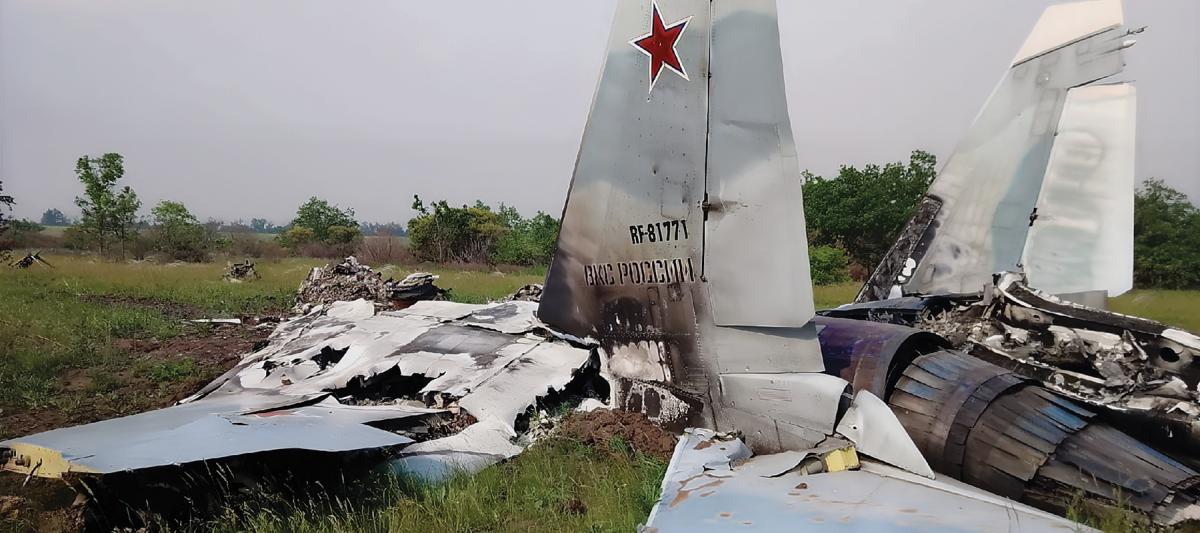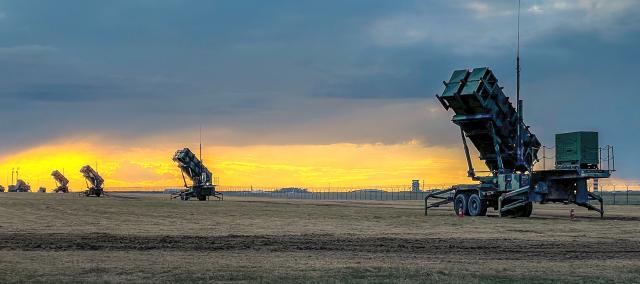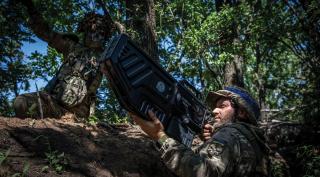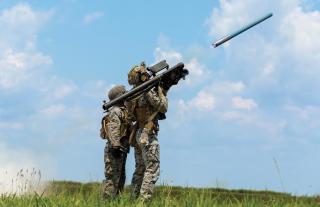Russia’s war in Ukraine demonstrates the changing character of war in the missile era. Reports from the battlefield make clear that, in 2022, Ukraine’s military nullified the larger and better equipped Russian Air Force. What is less clear is how.
At war’s outset, Russia’s air force had a greater than 10 to 1 advantage over Ukraine’s in total combat aircraft.1 Russia deployed some 350 for operations in Ukraine.2 In the first days of the war, Russia flew hundreds of sorties against Ukraine and had some success against Ukrainian air-defense systems. As the war turned from days to weeks, however, the Ukraine Defense Force neutralized Russia’s air force with dispersed, mobile, ground-based air-defense systems. Taking advantage of intelligence provided by the United States, Ukraine dispersed its forces, confusing the Russian military. Dispersed operations played an important role in the survivability of Ukraine’s air force.3
The war demonstrates that air and missile defense can have decisive effects on an overall campaign. It illustrates the primacy of modern air defenses over manned air forces for all but the most advanced radar-defeating aircraft, which only the United States produces.
The implications for the Marine Corps are clear. First, the large-scale use of missiles and drones in combat—and Ukraine’s successful use of dispersion and maneuver to counter Russia’s numerically superior force—validates the Marine Corps’ new warfighting concepts and force design initiative. Fleet Tactics and Naval Operations notes that “modern missiles have brought into question and sometimes overturned the principle of massing forces.”4 Expeditionary advanced base operations (EABO) require dispersal in the face of advanced sensors and ballistic and cruise missiles. The Ukrainians proved this concept sound.
But the war also has exposed gaps in doctrine and capabilities. The second edition of the Tentative Manual for Expeditionary Advanced Base Operations recognizes this and calls for the service to “initiate a doctrine review for Marine aviation” to support sea control and sea denial.5 The outcome of this review should reflect the importance of ground-based air and missile defense as an offensive fires function because it can yield decisive effects.
Air superiority in a conflict among roughly equal combatants may not be feasible, even temporarily. But the Ukrainians have demonstrated that air denial can facilitate battlefield success. And an air-denial strategy also may represent a more efficient use of available resources in some scenarios. The Marine Corps needs this capability to provide the most options for the joint force commander in a contested environment. The service should also accelerate efforts to field a broader range of mobile ground-based air-defense systems.
Patriot missile-defense system, which has limited numbers but high demand. U.S. Army (Christopher Smith)
The Limitations of Lessons
Lessons from Ukraine are not perfect analogs, but they are useful. For example, in terms of sheer numbers, a war in East Asia could resemble a maritime version of Ukraine against Russia. Regardless of location and adversary, a contested airspace with large numbers of missiles and drones is a near certainty. Both the Chinese and Russian militaries heavily emphasize the use of ballistic and cruise missiles. China has the most active and diverse missile development program in the world.6
Both Russia and China maintain a long-standing operational approach, called “active defense,” to deal with the perceived U.S. threat.7 Active defense for both countries is characterized by antiaccess capabilities. Chief of the General Staff for the Russian Armed Forces General Valery Gerasimov noted in 2016 that “the primary methods for achieving military objectives [in modern warfare] are non-contact actions against the enemy through the massive employment of precision-guided, long-range munitions from air, sea, and space.”8
Russia began its February 2022 invasion with a large and varied inventory of ballistic and cruise missiles.9 It relied heavily on Iskander ballistic missiles and Kalibr cruise missiles, firing more than 900 missiles of various types and sizes in just the first three weeks of the war.10 Over the first three months, the Russian military fired more than 2,000 cruise and 240 ballistic missiles at Ukraine.11 The previous best case study for the use of missiles in combat was the 1973 Arab-Israeli War, during which Arab forces fired possibly thousands of surface-to-air missiles and both sides’ navies exchanged 101 missiles.12
Initially, the Russian military seemed to pursue an air campaign that attempted to achieve air superiority, which generally aligned with Western expectations. The Russian Air Force launched hundreds of sorties into Ukraine during the first three days to attack air defenses and destroy Ukraine aircraft on the ground. Initial news reports said Russia’s “overwhelming air superiority” enabled it to destroy most of Ukraine’s air defenses and air force.13
In reality, the Russian Air Force met with mixed success. After the initial shock, the Ukraine military regrouped and began to put up an impressive defense that included various types of air-defense systems, denying the Russians air superiority. Over the course of the next several months, Russia’s air war consisted largely of missile barrages, with the air force relegated to sporadic close-air support missions and lobbing bombs from safe distances to avoid Ukraine air defenses. In the fall of 2022, the Russians began heavy use of cheap Iranian suicide (self-detonating) drones while continuing the missile barrages. By year’s end, the Ukrainian military continued to deny the manned Russian Air Force any freedom of movement in the airspace over Ukraine.
Surface to Air
The war underscores that in the missile era, ground-based air defense, employed effectively by a maneuver force using mission command and a strong will to fight, can have decisive effects on an overall campaign against a numerically superior force. Ukraine’s air-denial approach involved:
• Mobility to increase survivability
• Dispersion to complicate adversary targeting
• Selective use of ground-based air defense to reduce visibility and vulnerability
• Efficient choice of ordnance to conserve missiles
Ukraine’s military learned it is more cost effective to use comparatively inexpensive gun systems than expensive missiles against cheap drones; costly and scarce missiles should be expended only against ballistic missiles, cruise missiles, and manned aircraft. Ukrainian teams hunted Shahed drones with .50-caliber machine guns, thermal sights, and night vision goggles.14 Russia has, in some cases, sent swarms of half a dozen or more drones at a time.
One of the war’s most notable features has been the effectiveness of air defenses compared with the ineffectiveness of traditional manned air forces. Air defenses have been “extraordinarily effective” in denying air support and preventing any sort of combined-arms maneuver by either side, observes Franz-Stefan Gady, research fellow at the International Institute for Strategic Studies.15 Justin Bronk of the Royal United Services Institute concluded that the Russian Air Force has not been particularly effective at giving the Russian ground forces an advantage. This is largely because
of the Ukrainians’ effective use of mobile ground-based air defense.
At least as important as systems and weapons are the intangibles associated with the will to fight, mission tactics, and the execution of a sound strategy. In general, Russia’s military has failed to execute while Ukraine’s has succeeded. A wide range of reporting indicates Ukraine’s military has excelled at mission command and maneuver warfare, enabling it to achieve success against a much larger, better equipped force—at least on defense. The Ukrainians did this in part by using indirect approaches: targeting Russian supply lines; enabling decisions at the lowest possible level; and using mobility, speed, and opportunism. As a result, the Ukrainians pushed Russia’s military out of more than 2,000 square miles in the Kharkiv region.16
Ukraine’s success leads to the conclusion that today’s ground-based air defenses overmatch everything except, perhaps, the most advanced fifth-generation fighters such as the F-35. The effective use of modern, mobile, ground-based air defenses results in the inability of either side to effectively employ air forces. The result is mutual air denial or air parity.17 In addition, Ukraine’s use of maneuver and dispersion validates that being mobile, lightweight, and having a low signature are essential.
Sea Denial by Air
For the Marine Corps, the implication of the Russia- Ukraine War is that air denial can facilitate sea denial. That is, the service must pursue air denial as a capability alongside air superiority. This is already an implied task in the stand-in forces concept, which calls for the capability to create complete sea denial within a specified area in all five dimensions of the maritime domain, including in the airspace above.18 Stand-in forces must be able to “implement a feasible sea denial scheme of maneuver fast enough to frustrate the potential adversary’s plans.”19 Implementing the Tentative Manual’s call for a review of aviation doctrine—air and missile defense in particular—would offer multiple potential benefits, including:
• Efficient use of limited resources
• An ability to deny enemy air superiority with less risk and without requiring the use of scarce and costly advanced aircraft
• Freeing aircraft to achieve air superiority in one sector, while denying the enemy air superiority in another
• Contributing to complete sea denial in a contested maritime fight
• Enabling ground force maneuver when the joint force cannot achieve air superiority
Current Marine Corps doctrine states that antiair warfare serves two purposes: force protection and air superiority; it does not address air denial.20 This is the result of long-standing (but now dubious) assumptions about the U.S. military’s ability to control the air against any potential adversary. But joint doctrine emphasizes that air superiority is a prerequisite for battlefield success.21 As a result, the U.S. military has chosen for decades to invest in exquisite capabilities such as advanced radar-evading aircraft instead of ground-based air defense. As an expeditionary force, the Marine Corps plays an “away game” and therefore has chosen to pursue offensive capabilities to defeat adversary defenses rather than perceived defensive capabilities such as ground-based air defense. However, new joint doctrine notes that “Commanders should not expect air supremacy or superiority against a capable enemy.”22 Until the Marine Corps addresses air denial as a capability, the service is not prepared to achieve complete sea denial.
The Marine Corps should rely on a mix of offensive counterair—such as radar-evading F-35B and -C aircraft for suppression of enemy air defense—and ground-based air and missile defense for air denial. Air superiority should be the goal, but air parity appears more feasible. A mix of air superiority and air denial will provide more options for the fleet and joint force commanders, given the realities of potential adversaries’ capabilities.
The 3d Littoral Antiair Battalion (LAAB), established in 2022 within the 3d Marine Littoral Regiment, is the starting point for developing an air-denial capability. The LAAB exists to fight within contested battlespace and conduct “maneuverable ground-based air defense . . . in support of anti-air warfare and sea denial.”23
Besides amending doctrine, the Marine Corps needs to quickly field an operational medium-range surface-to-air missile system and other more advanced mobile, lightweight, low-signature ground-based air-defense systems. Versions of such systems are in development, but currently the Marine Corps operates only the low-altitude Stinger missile system. The Marine Corps’ Medium-Range Intercept Capability system will not be operational until fiscal year 2026. The Marine Corps could rely on the Navy’s highly capable ship-based air defense to defeat ballistic and cruise missiles, but once ashore, a Marine air-ground task force (MAGTF) needs greater capabilities than Stinger man-portable air-defense systems (ManPADs). The MAGTF cannot expect to rely on the Army’s Patriot ballistic missile defense—a system of limited numbers but high demand. Instead, it needs an organic mix of antiair guns, ManPADs, and medium-altitude surface-to-air missiles. A broad array of new, more capable drones will only add to the critical need for a diversity of air-defense systems. The Marine Corps cannot afford to waste scarce, six-figure Stingers against cheap suicide drones.
Finally, Marines must understand the philosophy of maneuver warfare and the imperative of mission tactics. Russia’s flaws in these areas suggest the U.S. military and its allies and partners enjoy an advantage over militaries that stifle initiative at lower levels. The Marine Corps must deliberately train subordinates to act based on commander’s intent and continue to push initiative down to the lowest level. Commanders at all levels need to be willing to accept risk to ensure subordinates have the freedom to make decisions and learn during training. As the Wall Street Journal reported in October 2022, “Ukraine’s command structure encourages junior officers to make in-the-moment battlefield decisions, an authority that they have used to seize opportunities and quickly take advantage of enemy weaknesses.”24 The Ukraine military’s success on defense reinforces
the classic tenets of maneuver warfare, including the critical importance of effective small unit leaders operating on the basis of commander’s intent, using mission-type orders.
For the Marine Corps, to ensure the MAGTF will be most ready when the nation is least ready, few issues are more urgent than air and missile defense. Air denial will enable the littoral force to achieve sea denial, expanding the options available to the joint force commander. The war in Ukraine validates that Marine Corps force design efforts are the right approach, but the service must put more urgency into air and missile defense. More important, the service must think critically about how to use its limited antiair resources within a larger maneuver warfare campaign to outthink its adversaries and win battles.
1. “The Curious Case of Russia’s Missing Air Force,” The Economist, 8 March 2022.
2. Justin Bronk, Nick Reynolds, and Jack Watling, The Russian Air War and Ukrainian Requirements for Air Defence (London: Royal United Services Institute for Defence and Security Studies [RUSI], 7 November 2022), 6.
3. Mykhaylo Zabrodskyi, Jack Watling, Oleksandr V. Danylyuk, and Nick Reynolds, Preliminary Lessons in Conventional Warfighting from Russia’s Invasion of Ukraine: February–July 2022 (London: RUSI, 30 November 2022), 53.
4. CAPT Wayne P. Hughes Jr. and RADM Robert P. Girrier, USN (Ret.), Fleet Tactics and Naval Operations, 3rd ed. (Annapolis, MD: Naval Institute Press, 2018), 272.
5. Tentative Manual for Expeditionary Advanced Base Operations, 2nd ed. (Washington, DC: Headquarters U.S. Marine Corps, May 2023), 5-4.
6. Missile Defense Project, “Missiles of China,” Missile Threat, Center for Strategic and International Studies, 12 April 2021.
7. Missile Defense Project, “Missiles of China”; and Michael Kofman, Anya Fink, Dmitry Gorenbury et al., “Russian Military Strategy: Core Tenets and Operational Concepts,” CNA, 6 August 2021, 10.
8. Charap et. al., “Russian Grand Strategy: Rhetoric and Reality” (Santa Monica, CA: Rand Corp. 2021), 27.
9. Missile Defense Project, “Missiles of Russia,” Missile Threat, Center for Strategic and International Studies, 14 June 2018.
10. David Vergun, “Russians Pounding Ukraine Cities with Long-Range Fires, Says Official,” Department of Defense News, 14 March 2022.
11. Bronk et al., The Russian Air War.
12. Hughes and Girrier, Fleet Tactics, 147; and Department of Defense, “DOD Weapons Systems Evaluation Group Report 249,” October 1974, 69–70.
13. The Wall Street Journal inaccurately reported that “Russia’s overwhelming air superiority allowed Moscow to destroy most of Ukraine’s air defense and air force.” See Yaroslav Trofimov et al., “Ukrainian Capital Rocked by Explosions as Russia Intensifies Attack,” Wall Street Journal, 25 February 2022.
14. Michael E. Miller and Anastacia Galouchka, “Ukraine’s Drone Hunters Scramble to Destroy Russia’s Fleet,” The Washington Post, 28 November 2022.
15. Silverado Policy Accelerator, Geopolitics Decanted podcast, 12 November 2022.
16. See Steven Pifer, “Putin’s Disaster in Ukraine,” Stanford Center for International Security and Cooperation, 15 September 2022.
17. Joint Publication 3-0: Joint Campaigns and Operations (Arlington, VA: Joint Chiefs of Staff, 18 June 2022), III-33; and author discussion with former F-15E pilot Col Christopher M. Marcell, USAF (Ret.), assistant professor, Joint Warfighting Studies, Air University, Maxwell Air Force Base.
18. Gen David H. Berger, USMC, A Concept for Stand-In Forces (Washington, DC: Headquarters U.S. Marine Corps, December 2018), 14.
19. Berger, A Concept for Stand-In Forces, 11.
20. Marine Corps Tactical Publication (MCTP) 3-20C: Anti-air Warfare, 15 February 2021.
21. Joint Publication 3-01: Countering Air and Missile Threats (Arlington, VA: Joint Chiefs of Staff, 2 May 2022), I-4
22. Joint Publication 3-0: Joint Campaigns and Operations, 18 June 2022, III-33.
23. MCTP 3-20C: Anti-air Warfare, 67.
24. Stephen Fiddler, James Marson, and Thomas Grove, “Ukrainian Strategy s Running Circles Around Russian Forces,” Wall Street Journal, 13 October 2022.






